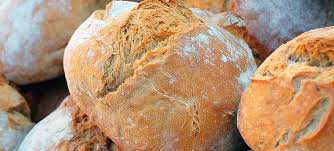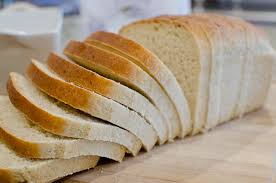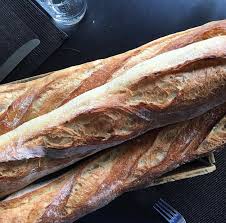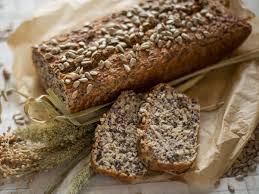The shape of bread
- rosemarydearman1
- May 20, 2018
- 5 min read
"Acorns were good until bread was found." Francis Bacon
Bread is delicious isn't it? And so many, many different kinds - four shown above - demonstrating different cooking methods too - from top to bottom left to right - mantou from china - steamed buns, youtiao from Asia - fried, sourdough from here there and everywhere in the western world - in this instance from Donna Hay - baked and naan from India - baked in a tandoor.
After yesterday's blog I was pondering on the different shapes of bread and why the western world in general goes for thick loaves in various shapes and the rest of the world go for various types of flatbreads. A sweeping generalisation of course, but like all sweeping generalisations, with an element of truth. And some nations don't seem to do bread at all - or very little anyway. And I asked myself why this should be.
Right here I will say that I know next to nothing about the food of sub-Saharan Africa, Polynesia and great chunks of South Africa so they won't feature in this post. I did find these intriguing Nigerian puff puffs though - although they did say they were really more like doughnuts than bread.

And in Ethiopia they make a thin flatbread. But the rest is a mystery to me. My guess is flatbread kind of things from various grains and roots.
Eastern Asia is not big on bread though. I guess this is very possibly because they don't seem to have much wheat although one wonders why. Well I guess the climate unsuitable for rice growing in Mesopotamia - although then again maybe it was back then. There would be room in China to grow wheat, and wheat - like all grains is just grass really. And the country is so vast that part of it must be suitable for growing wheat. Interesting is it not that the grass chosen there was rice and in the middle east it was wheat. In the Americas - corn. And when I looked at rice and bread on the net I mostly found recipes for the gluten free people. In India there seems to be a kind of chapati made from rice flour, but I'm guessing that there is something unsuitable about rice flour for bread in general. Even the chapatis were prepared quite differently - you seem to have to add hot water to the rice flour. They look perfectly good to me though.

I think, without going into it, that the gluten free loaves made with rice flour have all sorts of other weird additions to make it work and even then I'm told it's not that good - so not really a choice thing.
But it's not just a matter of the grains that are available - you seem to be able to make some kind of bread from virtually anything that you can dry and grind into a flour - even the above mentioned acorns. Apparently the Ancient Greeks, for example, made bread from acorns. And in times of famine some people still do. Yeast of course is a factor too - with yeast you can make bread rise further - or with some other fermentation method - like sourdough - or using yoghurt. But yeast is used in flatbreads too, so it's not that the West discovered yeast and the East didn't. This is just not true.
It might be something to do with ovens. Lots of flatbreads are made on griddles or some kind of flat iron, but then again lots are made in ovens too - pizza, naan, turkish pide ...
Even in ancient times the preference here in the west seems to have been to make bread of similar shape to that produced today.
The first two above are Egyptian, the next three are Roman and the last is medieval.
And although some might be tempted to say that primitive societies make flat breads because they are easier (no they're not) and they can be made on a stone, but (a) medieval Europe was pretty primitive really, and besides the middle eastern cultures of the middle ages and even earlier were hardly primitive.
“Our senses inform us of the colour, weight, and consistence of bread; but neither sense nor reason can ever inform us of those qualities which fit it for the nourishment and support of a human body.” David Hume
Today the western world seems to be in love with bread and has embraced wholeheartedly the flat breads of the middle east and India - their food too. Some of us even make our own. And this interest in other foods, a symptom of the shrinking of the world through faster travel times and modern media is increasing all the time. On my bookshelves I have a now pretty old book - I think it dates back to the 70s - called The Complete Book of Bread. It has one or two, at the most, recipes for flat bread and one of those was Scandinavian. Nothing on Turkish bread, pita, pide, naan or ciabatta or any of the other flat breads that now abound.
And let's not forget the despised sliced white bread. Not for nothing has the phrase "the greatest thing since sliced bread" entered the language. It was a revolution - not necessarily a good one, and at its worst in America where the bread is sometimes truly awful - all air and no content. However it made it so much easier for busy mums to make sandwiches and it was cheap. I don't know how much it costs these days as I don't buy it, but it's probably around $1.00 as the better bread that I buy is only $2.00 or $3.00.
"The art of bread making can become a consuming hobby, and no matter how often and how many kinds of bread one has made, there always seems to be something new to learn." Julia Child
So true. You have only to look in your local supermarket. Coles has recently introduced those dreadful looking charcoal buns, brioche hamburger buns and flat buns - for hamburgers too. I also noticed in Woolworths today that they have bruschetta (without the topping) and something called pizzetta. What else? German dark breads - when we lived in Adelaide we sometimes bought our bread from Hahndorf which was full of German bakers with their rich dark rye based breads, baguettes - how could one forget baguettes - and who first thought of making long stick like loaves - and why? Sour dough of every kind, tortillas, damper, ciabatta - not that I have ever seen this in Italy, egg bread. Yet again - so many things you can do with just two or three basic ingredients - a grain, a liquid and some yeast (or not).
It seems you only need imagination.












































Comments